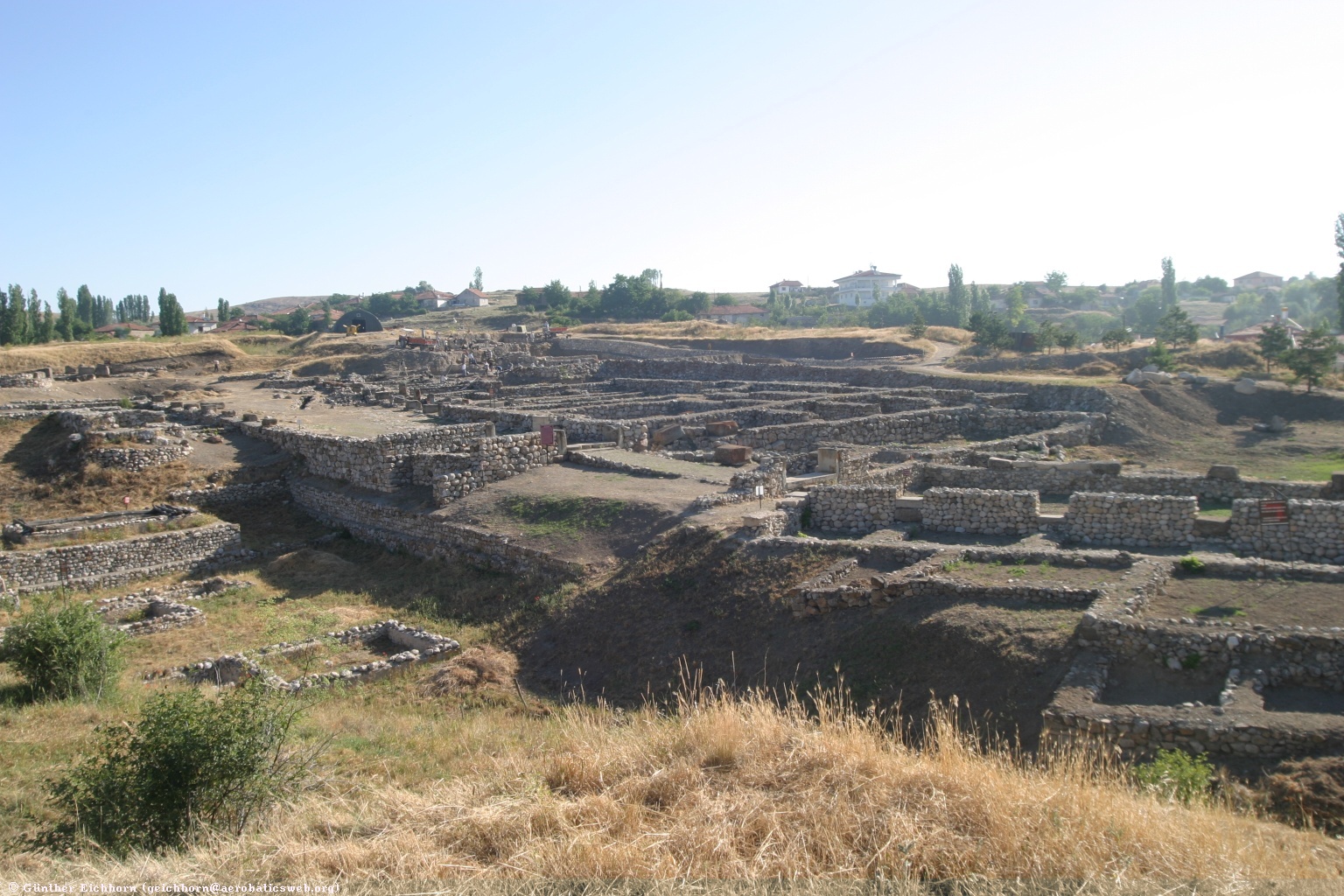|
Other Archaeological Sites / The Neolithic of the Levant (500 Page Book Online) Ancient Alaca Höyük Alaca Höyük was a Neolithic-Chalcolithic site and later a flourishing Hittite settlement during the Bronze Age. It is situated in (*)Alaca 35 km northeast of Bogazkoy where the ancient capital city Hattusas of the Hittite Empire was situated. Its Hittite name is unknown but there are very strong arguments for identifying it with Arinna ... The mound (Turkish höyük) at Alacahöyük was a scene of settlement in a continuous sequence of development from the Chalcolithic Age when the earliest copper tools appeared alongside the use of stone tools. During the Early Bronze Age the mound was the center of a flourishing Hattian Culture. Although the ethnic identity of these preliterate inhabitants is uncertain it is most plausible to assign them to a non-Indo-European population that preceded the arrival of the people now known as Hittites. The site has been continuously occupied ever since until today's modern settlement in the form of a small village. The extant remains at Alacahöyük date from the Hittite period ... NOTE: The Hattians were an ancient people who inhabited the land of Hatti in central Anatolia. The group was documented at least as early as the empire of Sargon of Akkad (circa 2300 BC) until it was gradually absorbed circa 20001700 BC by the Indo-European Hittites who therefore had become identified with the "land of Hatti". Destruction layers mark the end of several Anatolian sites at the end of the Late Bronze Age: among the best known are Hattua -- Alaca Höyük [etcetera]. The timing of these destructions however, many of which seem to have been cases of abandonment, is not well established and at least some sites were reoccupied or continued to be occupied in the early Iron Age ... Similarly there is little secure evidence to identify who may have been responsible for the destruction -- mainly by fire -- of these sites toward the end of the 13th century B.C.E. (1). As a result of the investigations and excavations which were carried out four cultural layers were determined in the mound which was a scene of settlements from the Chalcolitic Age to the present without any interruptions. These layers which covered the Chalcolitic -- Bronze Age -- Hititte -- Phrygian periods are divided into 15 architectural levels between them. Accordingly they are ...
1) Calcholithic Age : 4000-3000 BC layers 15-9
The first settlement of the mound built in the Chalcolitic Age was on a piece of land which was protected in the north by small hills and which was located above the water level, but did not progress beyond the status of being a small village ... 2) Old Bronze Age : 3000-2000 BC layers 8-5 3) Hittite Period : 1800-1200 BC layers 4-2 4) Phrygian Period : from 750 BC on layer 1
Early Bronze Age Tombs One of the most remarkable north central Anatolian plateau discoveries are the burials at Alaca Höyük. The date of the Alaca tombs has been in flux since their excavation in the 1930's but their attribution to the EB III Period (circa 2500 BC) has been accepted by most (*). The nineteen tombs consisted of wood and stone lined cist tombs each usually containing one individual although some had two or three ... Late Bronze Age Reliefs and Remains The most impressive remains are the reliefs carved in andesite. Most of the standing monuments are from the Hittite period. The town walls with their carved orthostats have inner and outer gateways with ramps for archers. The southern outer monumental gateway was set between two towers and guarded by two great sphinxes. In the doorjambs are two 13 foot hight monoliths which were carved to create 7 foot high sphinxes. Inside this Sphinx Gate was a large Hittite building complex that still requires excavation. The bases of the two towers by the Sphinx Gate are decorated with several orthostats. Most of the reliefs and sphinxes date to 14th century BCE ... (*)Alaca is one of the largest districts of Çorum Province in the Black Sea region of Turkey ...
(1) Crisis in Context: The End of the Late Bronze Age in the Eastern Mediterranean by A. Bernard Knapp and Sturt W. Manning in the American Journal of Archaeology (January 2016) Pages 99-149
|

